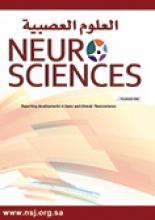Abstract
OBJECTIVE: To evaluate the predictors of neurological sequel in tuberculous meningitis (TBM).
METHODS: This study was carried out at the Department of Clinical Microbiology and Infectious Diseases, Haseki Training and Research Hospital, Istanbul, Turkey, between January 1998 and March 2009. Neurological sequels at 6 months of 160 adult patients with TBM who had been followed up were assessed retrospectively. The prognostic role of various demographic, clinical, laboratory, and radiological findings on admission, in prediction of neurological sequel development, were studied using a multivariate logistic regression. Clinical and therapeutic outcomes at 6 months were determined using a modified Barthel Index.
RESULTS: Twenty-seven (17%) patients died and 20 (13%) survivors had neurological sequelae at 6 months. Cranial nerve palsy, presence of tuberculoma, younger age, and basal meningitis were found to be significant predictors of neurological sequelae in univariate analysis, but only younger age (odds ratio [OR] 2.9, 95% confidence intervals [CI] 1.0-8.6, p=0.049), cranial nerve palsy (OR 3.9, 95% CI 1.8-8.8, p=0.001), and presence of tuberculoma (OR 1.9, 95% CI 1.0-4.2, p=0.048) were found to be significant predictors using multivariable logistic regression analysis.
CONCLUSION: Neurological sequelae were more common in patients with tuberculoma and cranial nerve palsy on admission. Development of neurological complications may be seen despite timely and effective anti-tuberculous therapy especially in younger patients.
- Copyright: © Neurosciences
Neurosciences is an Open Access journal and articles published are distributed under the terms of the Creative Commons Attribution-NonCommercial License (CC BY-NC). Readers may copy, distribute, and display the work for non-commercial purposes with the proper citation of the original work.






